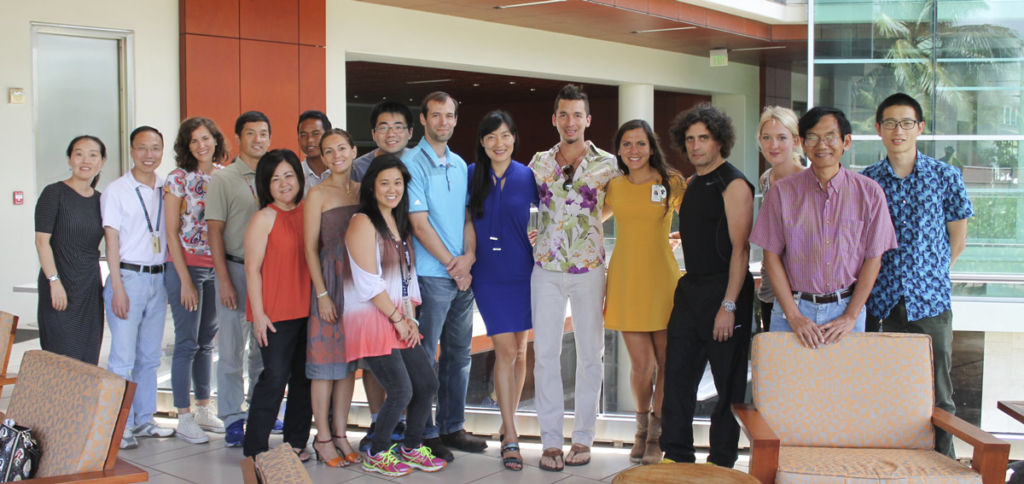
Dr. Michele Carbone’s Collaborations Around the World
This is far more than a “collaboration,” as we share ideas, reagents, and resources freely among our three laboratories. Haining and I work next to each other and our labs are a continuum on the Fourth floor of the Cancer Center. Together, we review all our data, have lab meetings, make hiring decisions, and share ideas, projects, and research grants. Harvey is a 9-hour plane flight away from us, but nevertheless he is a “real presence” in our lab, as I hope and I think we are in his lab.
For the past 20+ years I have called Harvey almost every day, often several times on the same day, when we have some new exciting data, and we review and discuss all data together and shared with him in over 100 publications and many grants. We have different areas of expertise that synergize together and give us the possibility to analyze and study a research problem from different angles. Most importantly, we admire and respect each other: there are and there have been many discussions and criticisms among us about data, research priorities, etc. This is how we make progress. We all know that critiques are intended in a constructive way, and we seek each other’s criticisms to improve. This may sound a politically correct fairy tale, but it is not: it is team-work at its best and there has never been a fight among us, because we completely trust each other.

Each of us is proud to work with a consistently talented group of post-doctoral fellows and researchers. Almost every one of our researchers has participated in one or more of our published, peer-reviewed papers. Below, you will see some photos with brief biographical information about some of the wonderful members of mine and Haining’s teams both now and in the past. Of course they have played a critical role in the success of our research. This page is in progress and names and photos are being added as I receive them. A special place in our team has been that of Professor Giovanni Gaudino, a very well respected molecular biologist and mesothelioma researchers, who after retiring from the University system in Italy joined our team in Honolulu for several years. He is now retired "again" in Switzerland, but he continues to play a critical role in our research and participates in our lab meetings via skype and tele-conferencing. Giovanni is one of those scientists who played a direct role in the development of the new science of "molecular biology", he understands molecular biology better than us all, and his critiques and advice have and continue to play a pivotal role in the progress of our research.
In addition to the “Core” team of these three laboratories, we work cooperatively with many laboratories across the world. Some of them are listed below.
Dr. Mitsuru Emi and Dr. Yoshie Yoshikawa at the Department of Genetics at Hyogo College in Japan have been working with us for the past several years to study genetic alterations in mesothelioma. This collaboration started when, following our paper in Nature Genetics which reported that 22% of sporadic mesothelioma had BAP1 mutations - finding independently reported at about the same time by the team of Mark Ladanyi at MSKCC- they published that over 60% of mesothelioma had sporadic BAP1 mutations.
I invited Dr. Emi, a surgeon with an outstanding knowledge in medical genetics, to a Symposium on BAP1 I held at the University of Hawaii and proposed that we do a bilateral study to see who was right. Of course, I thought we were right! We did a comprehensive genetic analyses and the results proved them right! We and the team of Ladanyi, had underestimated the extent of BAP1 somatic mutations in mesothelioma because the technique we and others had used, Sanger Sequencing and NGS, was very sensitive to detect point mutations but missed larger mutations that were insted detected by MLPA. Nasu M et al., Journal of Thoracic Oncology, 2015.
Mitsuru has now become a “full” member of our laboratory and he spends 1 week per month working with us. He played an important role in our recent paper Carbone et al., PLOS Genetics 2015 in which we traced the origin of germline BAP1 mutations to a couple that immigrated in the US in the early 1700s from Germany. We now have a new and very exciting paper under review with Dr. Emi and Dr. Yoshikawa and I hope to be able to discuss this research soon on this website (as soon as it is published).
Dr. Paolo Pinton and Carlotta Giorgi at the University of Ferrara in Italy. Paolo and Carlotta spend several months per year in our laboratory and we have worked in their laboratory, too. We have been doing very exciting research together, our discoveries are under review and I hope to be able to discuss them soon on this web-site (as soon as they are published).
Drs. Izzettin Y.Baris (deceased), Salih Emri and Murat Tuncer, at the University of Hacettepe in Ankara, Turkey and Drs. Umran and Meral Dogan. I have had the honor and pleasure to work with these fantastic physician scientists for many years to uncover the mystery of the mesothelioma epidemic in Cappadocia. Those studies led to the discovery that germline BAP1 mutations cause mesothelioma in some families in different parts of the world reviewed in Carbone M et al., Nature Review Cancer 2007 and 2013. Moreover, thanks to the Turkish Ministry of Health and to Dr. Murat Tuncer who had the time was the Director of Cancer Control in Turkey, two new villages were built in Cappadocia to prevent mesothelioma in new generations (see obituary I wrote for Dr. Baris on this website). I am looking forward to continue my work in Turkey that is now on hold because of the nearby war and the consequent political turmoil in the region.
Drs. Zhenying Guo and Weiming Mao, Zhejiang Cancer Hospital, Hangzhou, China. This collaboration started 3 years ago during a trip to China. We are investigating mesothelioma in China. Zhenying, a pathologist who specializes on the diagnosis of mesothelioma in China, has spent several weeks working with us at the University of Hawaii Cancer Center. We now have a new and very exciting paper under review and I hope to be able to discuss this soon on this website (as soon as it is published).
Drs. Francine Baumann - University of New Caledonia and Emanuela Taioli - Mount Sinai University, New York. These outstanding epidemiologists work with us to study environmental carcinogenesis and gene-environment interaction in different parts of the world. Moreover, some of these studies were with Dr. Aubrey Miller, now the Chief Medical Officer at NIEHS. Our work led to the implementation of preventive measures to reduce and eliminate exposure to erionite in Cappadocia and North Dakota, and to reduce exposure from asbestos in Nevada that are anticipated to save many future lives to mesothelioma. Moreover, our work led to the discovery that carriers of BAP1 germline mutations have much longer survivals compared to patients with sporadic mesotheliomas.

